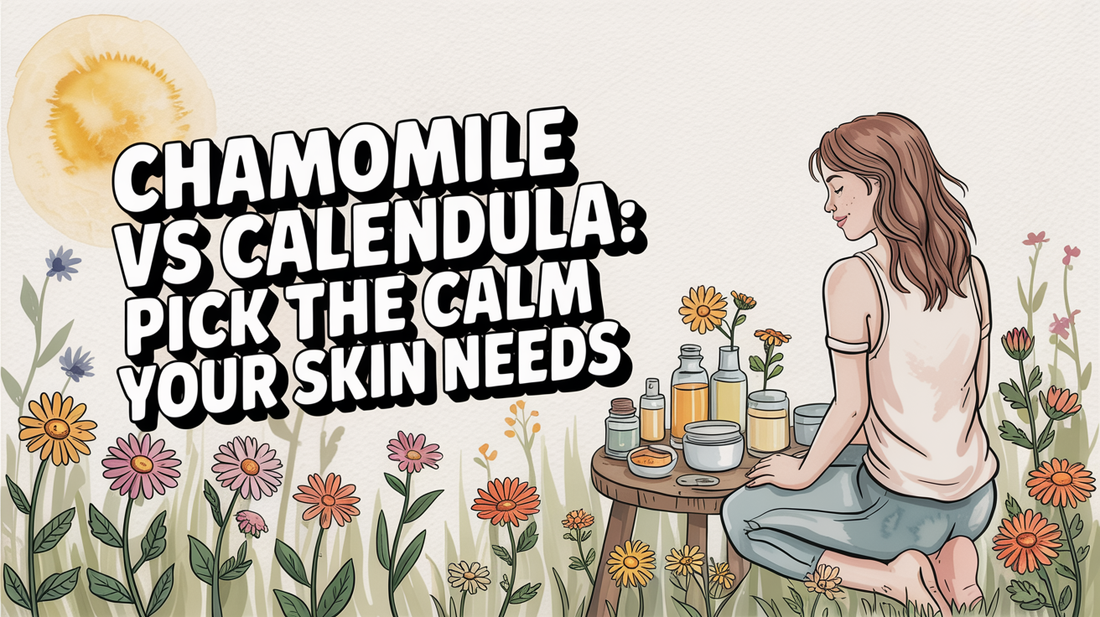Which is better for skin, chamomile or calendula?
chamomile vs calendula, which to choose, herbal pairing — If you're wondering which herb might be more beneficial for your skin, you're not alone! Many people face the dilemma of chamomile vs calendula. This post will help clarify when to choose one over the other and how to potentially combine them for even better results. We've organized this discussion into three key sections based on current research, giving you actionable insights to try tonight.
Compare Constituents & Goals
Chamomile and calendula are both celebrated for their skin-loving properties, yet they harbor distinct active ingredients that cater to different skin needs. Chamomile, especially German chamomile, is packed with compounds such as chamazulene and bisabolol, known for their calming and anti-inflammatory effects. Conversely, calendula boasts rich triterpenes and flavonoids aimed at supporting skin healing and regeneration.
The primary focus of chamomile is to soothe sensitive and inflamed skin, making it a go-to for conditions like eczema and dermatitis. On the other hand, calendula is great for enhancing the skin's healing process, making it ideal after minor cuts or burns. While both herbs offer antioxidant benefits that can protect your skin, chamomile shines at reducing redness, while calendula excels at cellular repair.
- Chamomile contains calming compounds such as bisabolol.
- Calendula promotes healing and tissue regeneration.
- Chamomile is best for sensitive, inflamed skin.
- Calendula aids in healing cuts and burns.
- Both herbs have antioxidant properties to protect against damage.
When to Choose One Over the Other ✨
Deciding between chamomile and calendula hinges on your specific skin issues. If you have highly reactive or inflamed skin, chamomile is your best bet due to its rapid soothing properties. It's a fantastic option for soothing conditions like eczema or psoriasis.
For those looking at healing benefits—think post-acne scars or minor cuts—calendula should be your go-to. It’s particularly effective for anyone dealing with dryness or damage from sun exposure. Chamomile tends to be gentler, making it suitable for delicate skin types, including babies, while calendula is versatile for all skin types, especially mature skin.
- Choose chamomile for sensitive, inflamed skin.
- Opt for calendula for wound healing and tissue repair.
- Chamomile is ideal for stress-related skin issues.
- Calendula is better for sun damage and age spots.
- Consider your skin type: chamomile for sensitive skin, calendula for all types.
Why We Recommend a Gentle Helper 🌿
Jane Vine Calendula Cream is specially designed for quick absorption and a lightweight feel. It may support your skin care routine while helping to calm irritation.
- Fast-absorbing and unfragranced.
- Soothing ingredients for comfort.
- Inspired by nature for gentleness.
Using Them Together 🔍
Combining chamomile and calendula can create a harmonious skincare blend that tackles multiple concerns at once. When used together, chamomile can provide immediate soothing relief, while calendula focuses on long-term skin health. This blend can be particularly effective for conditions such as eczema, where both inflammation control and barrier repair are needed.
You can find this combination in various products such as creams and oils, with preparation ratios typically ranging from 1:1 to 2:1, depending on whether you need more of chamomile’s soothing or calendula’s healing benefits. Many people enjoy making their own infused oils or DIY skincare recipes using both herbs, which can enhance their overall skincare routine.
- Mix chamomile and calendula for a dual-action approach.
- Use a 1:1 ratio for balanced effects.
- Infused oils or DIY recipes are great ways to combine them.
- This blend is safe for daily use and suits most skin types.
- Many commercial products successfully harness the power of both herbs.

